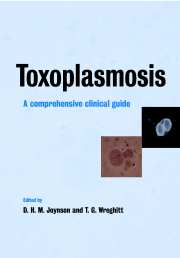Book contents
- Frontmatter
- Contents
- List of contributors
- Preface
- Historical perspective
- 1 Biology of toxoplasmosis
- 2 Immunology of toxoplasma infection
- 3 The epidemiology of toxoplasma infection
- 4 Infection in the immunocompetent
- 5 Toxoplasma infection in HIV-infected patients
- 6 Toxoplasma infection in immunosuppressed (HIV-negative) patients
- 7 Maternal and foetal infection
- 8 Prenatal screening for toxoplasma infection
- 9 Newborn screening for congenital toxoplasma infection
- 10 Infections in neonates and infants
- 11 Ocular infection
- 12 Laboratory diagnosis of toxoplasma infection
- 13 Antitoxoplasma chemotherapy
- 14 Toxoplasma vaccines
- Appendices: protocols for treatment and management
- 1 Suggested treatment protocols
- 2 Management of toxoplasma infection in pregnancy
- 3 Hygiene measures to prevent infection
- 4 Classification system and case definitions of Toxoplasma gondii infection in immunocompetent pregnant women and their congenitally infected offspring
- Index
3 - The epidemiology of toxoplasma infection
Published online by Cambridge University Press: 24 September 2009
- Frontmatter
- Contents
- List of contributors
- Preface
- Historical perspective
- 1 Biology of toxoplasmosis
- 2 Immunology of toxoplasma infection
- 3 The epidemiology of toxoplasma infection
- 4 Infection in the immunocompetent
- 5 Toxoplasma infection in HIV-infected patients
- 6 Toxoplasma infection in immunosuppressed (HIV-negative) patients
- 7 Maternal and foetal infection
- 8 Prenatal screening for toxoplasma infection
- 9 Newborn screening for congenital toxoplasma infection
- 10 Infections in neonates and infants
- 11 Ocular infection
- 12 Laboratory diagnosis of toxoplasma infection
- 13 Antitoxoplasma chemotherapy
- 14 Toxoplasma vaccines
- Appendices: protocols for treatment and management
- 1 Suggested treatment protocols
- 2 Management of toxoplasma infection in pregnancy
- 3 Hygiene measures to prevent infection
- 4 Classification system and case definitions of Toxoplasma gondii infection in immunocompetent pregnant women and their congenitally infected offspring
- Index
Summary
Introduction
Epidemiology is the study of the distribution and determinants of disease in populations. Its principle purposes are to inform decisions about allocation of healthcare resources, to provide a scientific basis on which prevention strategies can be based and to evaluate the effectiveness of those strategies.
Epidemiology addresses questions about prevalence, incidence and trends in infections and other diseases in different populations. In the case of toxoplasma infection the cause, Toxoplasma gondii, is known; nevertheless, epidemiological studies contribute to our understanding of routes of transmission and risk factors for acquiring the organism.
How prevalent is toxoplasma infection and is the incidence changing?
Prevalence
The most widely used method of assessing the frequency with which toxoplasma infection occurs in a given population – be it normal subjects or a particular group of interest such as pregnant women or HIV-positive patients – is to conduct a serological survey. Because, unlike most microbiological agents, the organism persists in its host for life and is capable of reactivating and causing disease, measurement of T. gondii IgG antibody provides an estimate of the prevalence (as compared to incidence, see below) of toxoplasma infection in the population of interest. Such studies using IgG alone cannot tell when their subjects acquired the infection, because IgG probably persists for life, so its presence may (depending on the assay used) indicate infection acquired anything from 2 weeks to decades ago. However, the detection of T. gondii-specific IgM is an indicator of relatively recent infection (see below).
- Type
- Chapter
- Information
- ToxoplasmosisA Comprehensive Clinical Guide, pp. 58 - 124Publisher: Cambridge University PressPrint publication year: 2001
- 16
- Cited by

